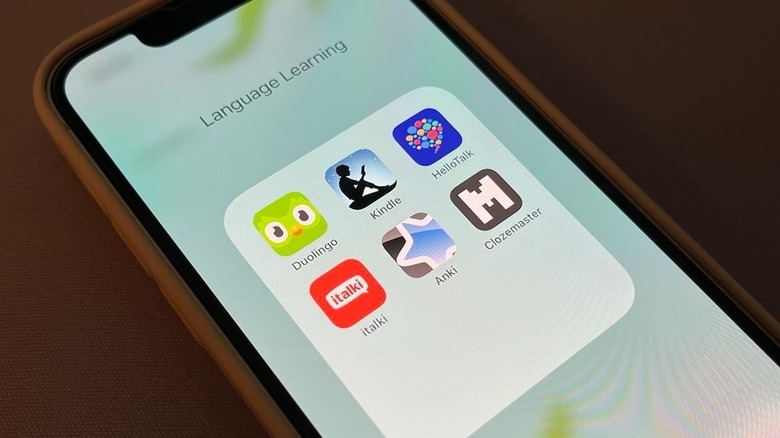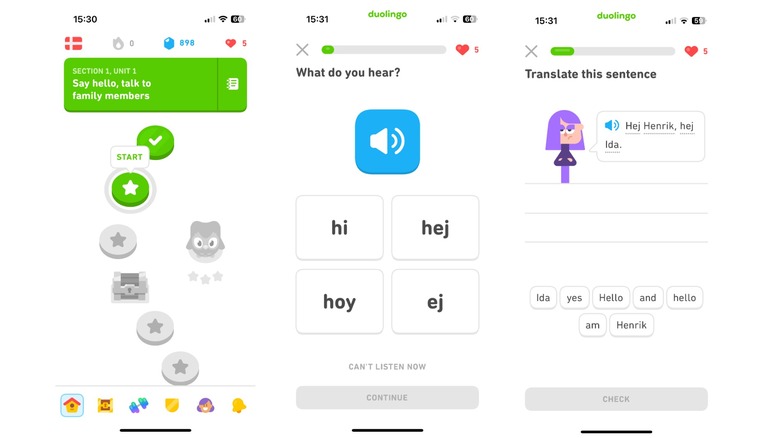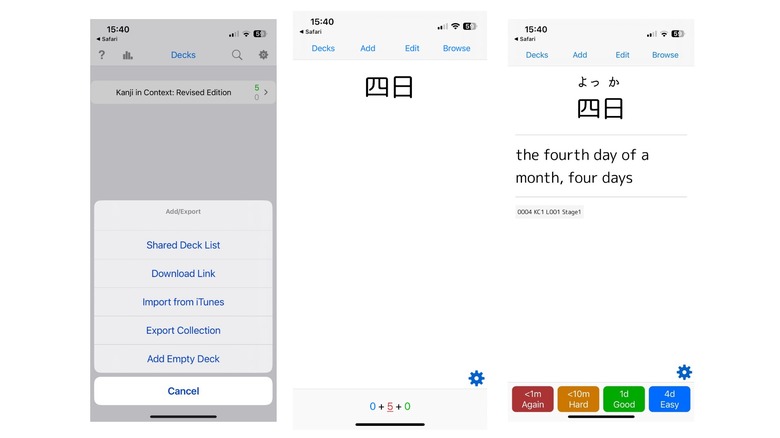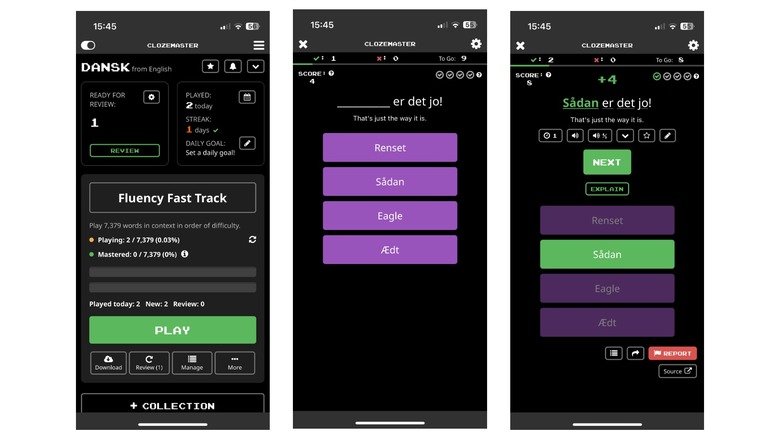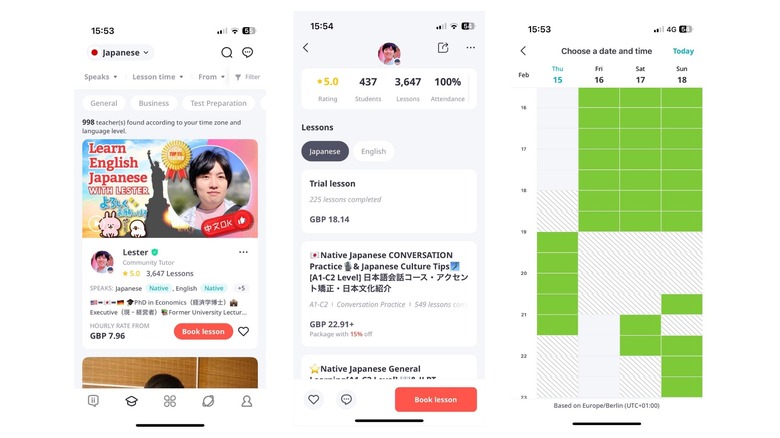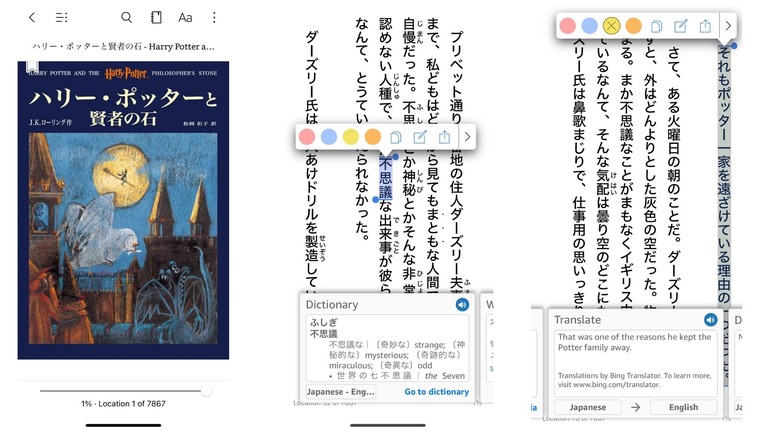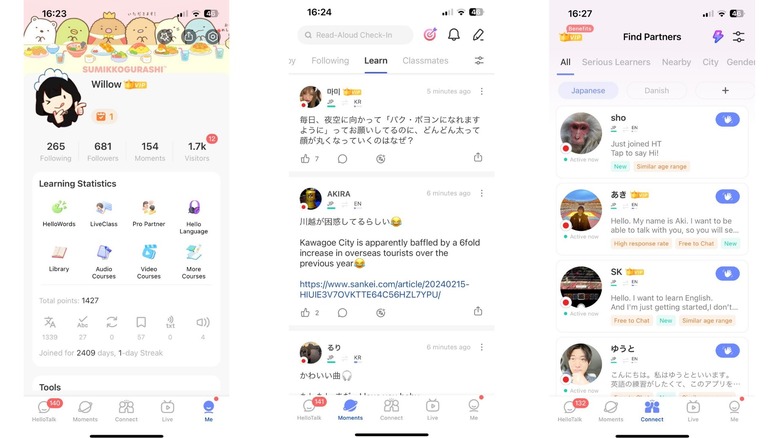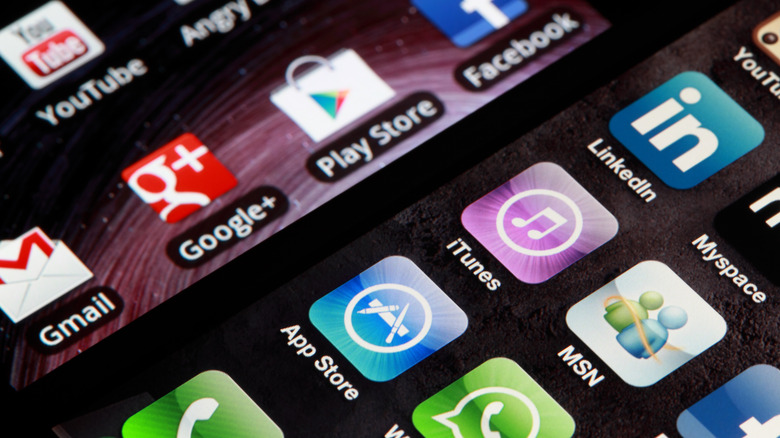6 Of The Best Apps For Language Learning In 2024
Learning a language is a long-term goal and a pretty intense hobby, but on the upside, there are almost countless ways to engage with your target language. Even a few minutes of practice while you're queuing for lunch is worthwhile, and that's where language-learning apps can help you out. In just a few taps, you can start drilling vocabulary, reading example sentences, and acing listening exercises wherever you are. There are also apps to help you with more involved practice as well, such as conversing with real natives or reading long-form content.
Of course, not all apps are created equal. Some cost too much, some aren't made well enough, some are full of mistakes, some are too rigid in the answers they'll accept, and so on. Over the decade I've spent studying Japanese, I've downloaded just about every language-learning app there is, and most of them get deleted again pretty quickly. A few, however, have sat on my home screen for multiple years and helped me during various stages of my study. I have six apps to recommend in total, and they all accommodate a range of different languages. I've considered the quality of the software, the content, and the overall influence the apps had on my own study. One thing I've been less fussy about is the price. However, language learning is worth investing in, and many of the apps on this list are at their best when paid for.
Duolingo
You'll likely find this app at the top of any "best language learning apps" list, and at the same time, you've probably seen language learning Redditors telling newbies to stay away. In my opinion, there's no need to stay away. While Duolingo isn't going to teach you a language from start to finish (spoiler: no single resource can do that anyway), it is a well-made, laid-back, and fun way to ease yourself into a new language.
When you're starting out, the most important thing isn't learning the right grammar first or drafting the ultimate study timetable—it's just about making sure you don't give up after two weeks. The convenience of Duolingo's app, along with its cute quizzes and motivating competitive elements, make it super easy for anyone to keep picking it up each day (on either iOS or Android). You don't need to invest a lot of time, you won't be confronted with anything too difficult, and you'll learn the type of basic words and phrases you can go ahead and use in shops and restaurants right away.
As for pricing, Duolingo's free version is honestly all most users need, but if you need more, the paid version costs $15 a month. You can start from the very beginning of a course or jump ahead to different sections and units by passing tests, and most languages have months of content for you to work your way through. For more details, check out this Duolingo vs. Babbel review.
Anki
There's nothing new about using flashcards to study, but now that we have our fancy smartphones, you don't need to write your own cards out on paper—you can just download pre-made decks and practice on your phone. Anki is one of the most well-known flashcard programs around, thanks to its spaced recognition system. Cards you're bad at come up often, and as you start to master them, they'll start coming up less and less. If you can keep getting it right even when you haven't seen it in a full week, you'll know that information is nice and secure in your head rather than temporarily floating around in your short-term memory.
Anki is a very efficient way to drill vocabulary and grammar, so if you like to be efficient, it might be the app for you. For Japanese learners, it's one of the most popular ways to learn the 2,000 Chinese characters we need to be considered literate. There are all kinds of decks available and various ways to study with each one. For instance, you can practice by seeing the target language and recalling the English or by seeing the English and recalling the target language. The latter is much harder, so people tend to switch once they've mastered it. You can also find fill-in-the-blank decks to help with vocabulary, verb conjugation, or grammar decks that drill you on grammar points. While the app is free on Android, it costs a hefty $24.99 on iOS!
Clozemaster
"Cloze" is a fancy word for a fill-in-the-blank sentence, and knowing this makes it pretty easy to guess what the Clozemaster app does. The app presents you with a sentence in your target language that has a word missing. Below, you'll have the full English translation and four answers to choose from. The useful thing about this study method is that it forces you to learn words in context—seeing them in action rather than in isolation.
Clozemaster also has a few useful features to help you when you need more information on a word. If you're using the pro version, you can click to get instant definitions, and if you're on the free version, you can click one of the links to travel to sites like DeepL or Wiktionary. Both free and paid users can also click the "explain" button to see an AI-generated explanation of what the sentence means. Since this is an AI language-learning feature, I'm not sure exactly how accurate it is, but I personally have had a good experience with it so far. I've even seen it give effective and accurate explanations for idiomatic phrases. The main Fluency Fast Track deck for each language is a collection of thousands of sentences that steadily increase in difficulty, and it makes for a great way to practice on the go. The app is available for free on iOS and Android, and the subscription cost is $10 a month.
iTalki
This app is a little different from the others because it's not aimed at providing mini-study sessions while you're out and about. Instead, it's a way to pay people to talk to you in your target language. iTalki is a platform of professional language tutors and nonprofessional community tutors you can work with over video calls. People tend to use the service in two main ways: for proper language lessons with certified teachers or for informal conversation practice with community tutors. The former is, of course, more expensive than the latter.
The app fills an important gap for people who are independently studying a language in a country where it isn't spoken. It's easy to read and listen to your target language all day, but a lot less easy to practice speaking. You can set up weekly lessons for regular practice or use the service to practice for a specific event. I personally used it to practice for Japanese interviews, for example. Every tutor has a page full of information about themselves and an introduction video showcasing them speaking in the different languages they work in. Prices start at $10 per hour for professional teachers and $5 per hour for community tutors, but you'll find some people charging as much as $40 per hour for their services. You can use the app on your phone, tablet, laptop, or desktop—wherever it's easiest for you to take video calls, and the app is available on both iOS and Android.
Kindle
This isn't a language-learning app, but it's definitely an app that's useful for learning languages. The Kindle store is worldwide, and it's easy to buy books in a range of languages no matter where you're buying from. For example, you'll find the Harry Potter books in almost every language you can think of. Reading practice is super important when learning a language, and the easier it is for you to buy books in your target language, the more you'll be able to match your reading material with your hobbies and interests.
The Kindle app also has a great feature to aid your reading—dictionaries. For example, German, French, Hindi, Japanese, Italian, Spanish, Portuguese, Chinese, Arabic, and Dutch have default foreign language dictionaries available on the Kindle app. With one of these dictionaries set as the default, you can read a book in your target language. When you select a word, it will instantly show its dictionary entry, including the English definition. It's also possible to buy other Kindle default dictionaries on Amazon and download them on the app. Being able to quickly lookup a word without leaving the app can smooth out your reading experience and make it a lot easier to practice without getting frustrated, and less frustration means less chance of giving up! You can get the app for free on PC, Mac, App Store, and Google Play. Prime members get a library of free titles, and Kindle Unlimited costs $11.99 a month.
HelloTalk
The biggest tip for success when learning a language is to maximize the amount of time you spend engaging with it—and one thing the modern human is world-class at engaging with is social media. HelloTalk is a social media app specifically aimed at language learners—it aims to get you reading and writing in your target language with a Facebook-like news feed and partners you with natives so you can chat, call, or even meet up. Posts on HelloTalk can include text, photos, and voice recordings, and there's a special feature for making corrections to other people's posts or messages.
Many users write their posts in both their native and target language, as this gives natives in your target language a chance to read English and helps people understand what you wanted to write so they can correct you more effectively. You can also filter your news feed to show only people nearby, people you follow, people posting in your target language, or people studying the same language as you.
One downside to HelloTalk is that it has gotten a bit greedy in recent years. There's now a noticeable difference in the number of users who see your posts if you have a paid account compared to a free account. You can access Hello Talk on web browsers, App Store, or Google Play and the paid version costs $10 a month, $60 a year, or $190 as a one-time purchase.
How I picked these apps
I didn't just trial these apps for two weeks before recommending them; I've used them all for quite a while. I've used Hello Talk for around seven years, Anki for around nine years, and iTalki for about five years. Clozemaster and Duolingo are a little more recent; I started using them to study Danish after moving to Denmark a few years ago. The fact that I've continued to use them all for so long is the main reason they're included on this list. A good-looking app is great, free apps are exciting, and apps that promise to make you fluent are tempting, but usability and longevity are what really matter. Of course, they did have to meet other standards, too. These apps won't slow your phone down or crash unexpectedly; they all work as intended. They all offer accurate, relevant, and useful language learning content and guidance.
One of the keys to success with language learning is variety, so I also tried to include apps that cover different areas. Kindle and Hello Talk provide reading practice, Anki and Clozemaster focus on vocabulary, iTalki allows conversation practice, and Duolingo is a great all-rounder for beginners. Aside from iTalki, all of the apps are also great for on-the-go learning, so you can still get some micro-study sessions in, even on a busy day.
